 |
Petrovaradin Fortress
Novi Sad, Serbia
|
|
 |
Constructed: 1692-1776
Used by:
Austria, Hungarian rebels, Yugoslavia
Conflicts in which it participated:
War of the Holy League,
Austro-Turkish War of 1714-18,
Hungarian Revolution of 1848
|
Petrovaradin Fortress is at one of those very special places on this earth that has been intensely attractive to humans ever since there were humans. Recent diggings there revealed the remains of a settlement dating from 19,000 to 15,000BC, which means that folks have lived at this location continuously since the Paleolithic Age.
In 2005 archaeologists found ramparts that dated from the Bronze Age, around 3,000BC. These may have been the first fortifications at this site, but who knows what weird little pile of sticks 'n' rocks those paleolithic dudes might have scraped together? |
 |
|
|
This is at least partially thanks to the life-giving properties of the mighty Danube River. The second-longest river in Europe (after the Volga), the Danube River basin fostered some of the world's earliest human cultures.
The Romans occupied most of what is today Serbia in the 2nd century BC, and built the first large fortification, named Cusum, at the location of our current interest. Those wicked Huns did away with Cusum in the 5th century when they were doing away with much of the rest of the Roman Empire, but by the end of the 5th century the Byzantines were back in the Danubian saddle. They built a fortified town there called Petrikov, after Saint Peter, which would eventually magically transmogrify into Petrovaradin.
|
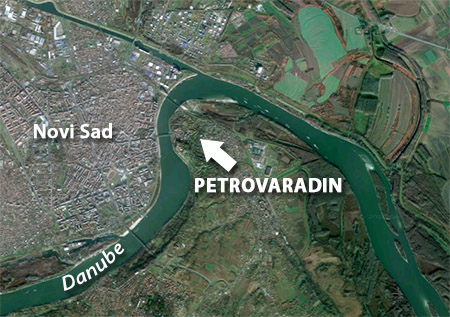 Historically, such bends in major rivers have frequently spontaneously sprouted starforts. Historically, such bends in major rivers have frequently spontaneously sprouted starforts. |
 |
Over the next several hundred years Ostrogoths, Gepids, Avars, Franks, Great Moravia, Bulgaria, and once again the Byzantines all took turns at being in charge of this region, until things settled down a bit when the Kingdom of Hungary took over in the 11th century.
By the 13th century, the only fortification left was the slowly disintegrating Roman Cusum, until Hungarian King Béla IV (1206-1270) sent a group of Cistercian monks to the area in 1235. The monks built a monastery called Belakut atop the remains of the Roman fortress, which would be the seed from whence grew Petrovaradin Fortress. Sort of. |
|
Bits & pieces were added to the monastery as time went on. Threat of Turkish incursion sparked a major fortification effort in the early 16th century, but the monasteryfort fell to the Turks in 1526 after a two-week siege.
The Ottoman Turks spent the next century busily conquering as much of Europe as it could reach. One of the earliest engagements of the War of the Holy League (1683-1699) was the Battle of Vienna (September 11-12, 1683), which is remembered as the beginning of the end of the Ottoman Empire's European expansion. Petrikov (or whatever the Turks had taken to calling it, which was probably something other than Petrikov) fell to the Austrians in 1687.
|
Austrian engineers took one look at the fortified monastery of Belakut, sneered, and tore it down. Beginning in 1692, the 80-year process of building a stellar, state-of-the-art Austrian starfort on the Danube got underway. Plans for the massive fortress were initially made by Austrian engineer Colonel Count Mathias Keyserfeld (Colonel and Count! A double threat!), and completed by Italian Count Luigi Ferdinando Marsigli (1659-1730).
Petrovaradin Fortress' main element is Fortress Leopold, the center-and uppermost part of the image at the top of this page, whose flanks are supported by two massive outerworks. Anyone trying to claw their way into Fortress Leopold from the landward side through these defenses would simply get dizzy and lost.
|
 |
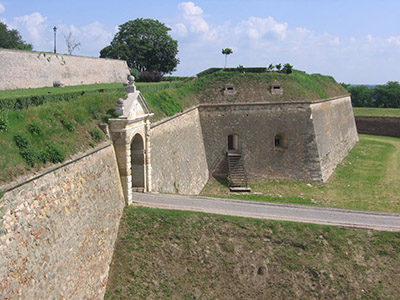 The main gate of Fortress Leopold, Petrovaradin's primary work. The main gate of Fortress Leopold, Petrovaradin's primary work. |
|
The Ottomans, meanwhile, hadn't yet comprehended that their days of absorbing Europe were over, probably because they didn't have Wikipedia to tell them so. Accordingly, an Ottoman horde arrived at Petrovaradin Fortress on September 9, 1694, and laid siege to what was sure to have been a particularly perilous pile of pieces, as work on the starfort-to-be had commenced less than two years previously. Fortunately, the weather turned yucky in October, and the assumedly non-waterproof Turks abandoned their siege after only 23 days.
|
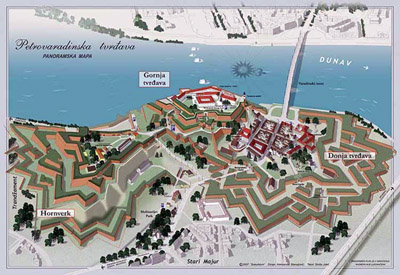 A map of Petrovaradin Fortress in a language that I don't speak. Although the term "Panoramska Mapa" makes me suspect that they're just making this "language" up. A map of Petrovaradin Fortress in a language that I don't speak. Although the term "Panoramska Mapa" makes me suspect that they're just making this "language" up. |
 |
The War of the Holy League ended with the Treaty of Karlowitz in 1699, the Holy League (including Austria, the Holy Roman Empire, Spain, and Russia among many others) victorious. The Turks had been pushed out of much of the European lands they had conquered, but were far from defeated. Belgrade, just 60 miles down the Danube from Petrovaradin, was still an Ottoman stronghold. By 1716 the Turks were on the march again, in the form of an army 150,000 strong, led by Grand Vizier Damat Ali (1667-1716).
By this time Petrovaradin Fortress' first iteration was complete, albeit without the dizzying array of outerworks that would be added later. The fortress was garrisoned with 8,000 Serbian troops.
|
|
The Austrian army, whose numbers are inexactly estimated to have been from 60,000 to 91,300, chose Petrovaradin as the location at which they would stop this latest Ottoman onslaught, and stop it they did. Led by Prince Eugene of Savoy (1663-1736), who appears to have had himself quite an unlikely pile of fetchingly grey hair, completely routed the Ottomans on August 5, 1716 at Petrovaradin.
|
Further additions were made to Petrovaradin Fortress from 1753 to 1776, adding much of the outerworks we see today. Also added were nearly 10 miles of underground tunnels: Mines, in four intricate levels. Should anyone try digging their way into the fortress, they would get just as lost and bewildered as if they tried to pick their way through all of the complicated works on the surface.
On February 1, 1748, Novi Sad achieved City Status. Prior to this the region was simply known as the Military Frontier, but the threat from Turkey was pretty much over by 1748, and "Military Frontier" doesn't sound like a very pleasant vacation destination.
|
 |
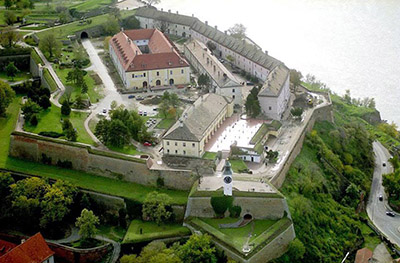 The insides of Fortress Leopold. Generally forts built by empires are named for their emperor, and this was no exception: Leopold I (1640-1705), Holy Roman Emperor, was the contemporary dude on the throne. The insides of Fortress Leopold. Generally forts built by empires are named for their emperor, and this was no exception: Leopold I (1640-1705), Holy Roman Emperor, was the contemporary dude on the throne. |
|
In 1848, several local independence movements in Habsburg (Austrian) lands erupted into revolution. The Hungarian Revolution (1848-1849) brought imperial Austrian troops to Petrovaradin Fortress in June of 1849, when the fort's Hungarian garrison had stuck its collective tongue out at Austria and locked the doors. Austrian troops blockaded the fort for a period, hoping to starve out its wayward inhabitants, but the revolutionary garrison remembered they had a fort full of cannons and bombarded Novi Sad on June 12. Most of the town was destroyed, along with several thousand of its residents, which surely warmed the hearts of the local populace towards the high ideals of the Hungarian revolution.
The Austrian Empire was finally dissolved at the end of the First World War (1914-1918), and Petrovaradin became part of the Kingdom of Serbs, Croats and Slovenes. This mouthful was changed to the Kingdom of Yugoslavia in 1929.
|
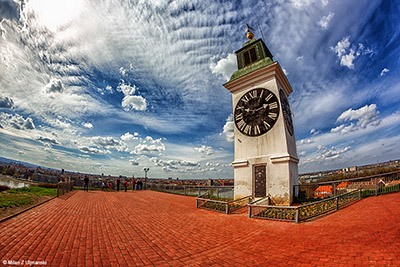 The Clock Tower (which doesn't really bend like that) on Fortress Leopold's northern bastion is one of Novi Sad's most beloved landmarks. Weirdly, the arms on the clock are reversed from the standard: The long arm denotes the hour, the short arm minutes. Supposedly this was done to make it easier for local fishermen to comprehend the time, but it suggests that local fishermen don't understand how clocks work. Thanks for the kooky picture, Milan Z Uljmanski! The Clock Tower (which doesn't really bend like that) on Fortress Leopold's northern bastion is one of Novi Sad's most beloved landmarks. Weirdly, the arms on the clock are reversed from the standard: The long arm denotes the hour, the short arm minutes. Supposedly this was done to make it easier for local fishermen to comprehend the time, but it suggests that local fishermen don't understand how clocks work. Thanks for the kooky picture, Milan Z Uljmanski! |
 |
During this period, many of the area's 18th century starforts, including Slavonski Brod Fortress and Karlovac Fortress were razed due to the fact that they were militarily unnecessary and taking up valuable space in rapidly-expanding cities. The man responsible for these destructions was engineer Colonel Dragoš Đeloševič, who fortunately determined that Petrovaradin Fortress should be left standing in all its glory, as it was "far too beautiful" to be torn down. Couldn't agree with you more, Colonel Đeloševič. Since 2001, Petrovaradin Fortress has hosted the annual EXIT Festival, a summer music concert which has grown to one of the largest in Europe, and has featured such acts as the Beastie Boys, Sex Pistols, Garbage, Guns 'n' Roses and Snoop Dogg. One imagines Snoop Dogg to be a particularly knowledgeable starfort enthusiast. |
|
And speaking of knowledgeable starfort enthusiasts, Petrovaradin Fortress has been suggested for addition to this site more than once, but most recently by Nenad Šeguljev. Thanks, Nenad!
|
|
|
|
|
|
 |




